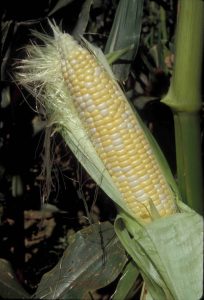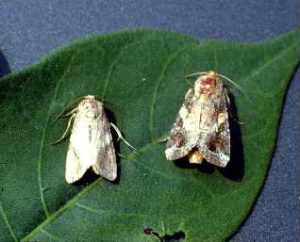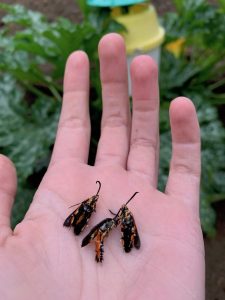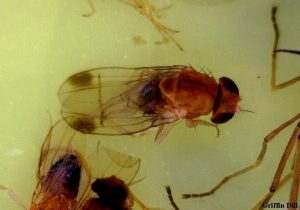Sweet Corn IPM Newsletter No. 3 – July 20, 2020
Sweet Corn IPM Newsletter No. 3 – July 20, 2020
Click on photos to enlarge.
PEST PRESSURE INCREASES FOR SILKING CORN
Corn Earworm and Fall Armyworm Numbers Higher at Most Sites
SITUATION
With favorable weather in much of the state it continues to push corn development, with more fields coming into silk. However, some sites received very heavy downpours and hail causing some lodging and shredding of plants. Silking fields are at risk for infestation from incoming corn earworm and fall armyworm, as well as European corn borer. Higher moth counts were found in some, but not all locations this week, and not all sites have corn in silk stage yet.
European corn borer:

Larval feeding injury was over the 15% control threshold for pre-tassel corn in Sabattus this week. Sprays for ECB as corn moves from pre-tassel to tassel stage can be very effective because the larvae are often exposed as they move from one feeding site to another during this time. A spray to protect silking corn from ECB was recommended in Poland Spring, where the threshold of five moths trapped in a week was exceeded. Moths will lay eggs on flag leaves of silking corn, and the larvae move directly into the ears.
Corn earworm:

We continue to catch moths in most locations this week, and the numbers were generally higher. Early silking corn should be protected at this time if more than one moth has been caught in traps. A six-day spray interval for silking corn was recommended in: Biddeford, Corinth, Farmington, Sabattus and one Lewiston site. A five-day spray interval was recommended for silking fields at one Cape Elizabeth site, and one Wells site. A four-day spray interval was recommended for one Cape Elizabeth site.
Fall armyworm (FAW):

Moths were caught at more locations and in higher numbers this week, although armyworm is not yet as widespread as corn earworm. Moths exceeded the three per week threshold for silking corn in: Biddeford, New Gloucester, Oxford, one Cape Elizabeth site, and one Wells site. Sites presently under a spray interval for corn earworm should not need any additional sprays for FAW. Very little FAW larval feeding damage has been found so far, but this will likely become a more widespread problem soon.

Squash vine borer
moths were caught in pheromone traps in Biddeford (17), Farmington (8), and Oxford (8) this week. All sites were over the threshold of five moths per week, so sprays to protect summer and winter squash, and pumpkins were recommended. Sprays should be targeted for the base of the plants where the moths lay their eggs. See the 2020-2021 New England Vegetable Management Guide for control options.
Spotted wing drosophila:

The first capture of spotted wing drosophila occurred this week in berry fields in southern Maine. These small fruit flies can cause serious fruit losses in late strawberries, raspberries, blueberries and other soft fruits. This pest has already reached damaging numbers in southern New England, which is early, based on what we’ve seen in the past few years. For more information visit our website:
UMaine Highmoor Farm News Blog
Sincerely,
David T. Handley
Vegetable and Small Fruit Specialist
Highmoor Farm Pest Mgmt. Unit
P.O. Box 179 17 Godfrey Drive
52 U.S. Route 202 Orono, ME 04473
Monmouth, ME 04259 1.800.287.0279
207.933.2100
| Location | CEW
Moths |
ECB
Moths |
FAW
Moths |
%Feeding
Damage |
Recommendations / Comments |
|---|---|---|---|---|---|
| Biddeford | 2 | 0 | 4 | 9% | 6-day spray interval for all silking corn |
| Bowdoinham | 1 | 0 | 1 | 0% | No spray recommended |
| Cape Elizabeth I | 5 | 0 | 1 | 0% | 5-day spray interval for all silking corn |
| Cape Elizabeth II | 8 | 2 | 9 | 5% | 4-day spray interval for all silking corn |
| Charleston | 0 | 0 | 0 | 0% | No spray recommended |
| Corinth | 2 | 0 | 1 | 0% | 6-day spray interval for all silking corn |
| Dayton I | 0 | 0 | 0 | No spray recommended | |
| Dayton II | 1 | 0 | 0 | 0% | No spray recommended |
| Farmington | 2 | 0 | 0 | 2% | 6-day spray interval for all silking corn |
| Levant | 5 | 4 | 0 | 0% | No spray recommended (no silking corn) |
| Lewiston I | 0 | 0 | 1 | 0% | No spray recommended |
| Lewiston II | 2 | 0 | 0 | 0% | 6-day spray interval for all silking corn |
| Monmouth | 0 | 1 | 0 | 3% | No spray recommended |
| New Gloucester | 0 | 0 | 4 | 6% | One spray for FAW on silking corn |
| Oxford | 0 | 1 | 4 | 0% | One spray for FAW on silking corn |
| Palmyra | 0 | 0 | 0 | 1% | No spray recommended (no silking corn) |
| Poland Spring | 1 | 5 | 1 | 0% | One spray for ECB silking corn |
| Sabattus | 3 | 0 | 1 | 23% | 6-day spray interval for silking corn, 1 spray for ECB |
| Wayne | 0 | 3 | 0 | 4% | No spray recommended |
| Wells I | 4 | 1 | 1 | 0% | 5-day spray interval for all silking corn |
| Wells II | 1 | 0 | 3 | 10% | One spray for FAW on silking corn |
CEW: Corn earworm (Only fresh silking corn should be sprayed for this insect.)
ECB: European corn borer
FAW: Fall armyworm
| Moths caught per week | Moths caught per night | Spray interval |
|---|---|---|
| 0.0 to 1.4 | 0.0 to 0.2 | No spray |
| 1.5 to 3.5 | 0.3 to 0.5 | Spray every 6 days |
| 3.6 to 7.0 | 0.6 to 1.0 | Spray every 5 days |
| 7.1 to 91 | 1.1 to 13.0 | Spray every 4 days |
| More than 91 | More than 13 | Spray every 3 days |
European Corn Borer Thresholds
Whorl stage: 30% or more of plants scouted show injury.
Pre-tassel-silk: 15% or more of plants scouted show injury.
Silk: 5 or more moths caught in pheromone traps in one week.
Thresholds apply only to corn with exposed fresh silk. Lengthen spray intervals by one day if maximum daily temperature is less than 80°F.
IPM Web Pages:
Integrated Pest Management in Maine
Integrated Pest Management Data Visualization Tool
UMass Cooperative Extension Website
Where brand names or company names are used, it is for the reader’s information. No endorsement is implied nor is any discrimination intended against other products with similar ingredients. Always consult product labels for rates, application instructions and safety precautions. Users of these products assume all associated risks.
The University of Maine is an equal opportunity/affirmative action institution.
